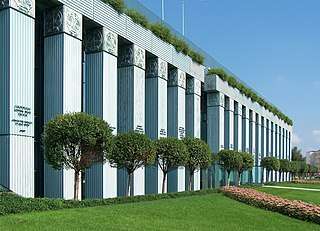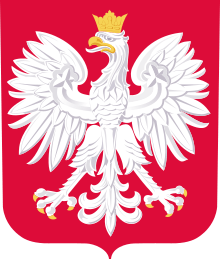Supreme Court of Poland

 |
|---|
| This article is part of a series on the politics and government of Poland |
|
|
Related topics
|
The Supreme Court (Polish: Sąd Najwyższy) is the highest court in the Republic of Poland. It is located in the Krasiński Square, Warsaw.
Function
The Supreme Court supervises the adjudication in:
- General courts: these are district, regional, and appeal courts. They adjudicate in the areas of civil, criminal, family and labour law.
- Military courts: these are circuit and garrison courts. They deal with matters relating to crimes committed by soldiers in active service, civilian employees in military units, and prisoners of war.
The Supreme Court is the court of last resort of appeal against judgements in the lower courts. It also passes resolutions to clarify specific legal provisions and resolve disputable questions in specific cases. These however are not (at least technically) legally binding.
Appointment of judges
The President of the Republic of Poland appoints Supreme Court judges for an indefinite period. This is done upon a motion of the National Council of the Judiciary. The President also selects the First President of the court from candidates presented by the General Assembly of the Supreme Court. The First President holds office for a six-year term, though he or she may be dismissed by the Sejm upon a motion by the President of the Republic of Poland if found convicted of a crime.
In July 2018 a new law came into force which lowers the mandatory retirement age from 70 to 65. The introduction of this law is contested and the constitutionality of the law is being assessed. Critics have argued the law is aimed at removing non-pliant judges and installing PiS-led government appointees.
2017-2018 Constitutional Crisis
In 2017 the Polish government passed a law which would have forced all Supreme Court judges into mandatory retirement apart from those granted an extension by the Minister of Justice. The bill was passed in the Polish Sejm and the Senate however following mass protests against the bill it was ultimately vetoed by President Andrzej Duda on July 24, 2017. A revised bill reduced mandatory retirement age of judges from 70 to 65. The bill was later signed by President Duda and came into force in July 2018. The law effectively retires 40% of the Supreme Court bench including the First President of the Supreme Court, Malgorzata Gersdorf.
Opposition groups, the EU, the Supreme Court and the National Council of the Judiciary (2017) have claimed the law is unconstitutional because it violates the principles of the independence of the judiciary. In August 2018 the Supreme Court sent questions to the European Court of Justice regarding the reforms. Under European Union treaties the court can prevent the law from coming into force if it undermines EU treaties regarding judicial independence.
List of First Presidents of the Supreme Court
- Stanisław Pomian-Srzednicki (1 September 1917 – 28 February 1922)
- Franciszek Nowodworski (1 March 1922 – 3 August 1924)
- Władysław Seyd (22 September 1924 – 17 January 1929)
- Leon Supiński (17 January 1929 – 1 September 1939)
- Wacław Barcikowski (26 January 1945 – 12 November 1956)
- Jan Wasilkowski (12 December 1956 – 22 May 1967)
- Zbigniew Resich (23 May 1967 – 21 January 1972)
- Jerzy Bafia (21 January 1972 – 1 April 1976)
- Włodzimierz Berutowicz (1 April 1976 – 14 May 1987)
- Adam Łopatka (14 May 1987 – 30 June 1990)
- Adam Strzembosz (1 July 1990 – 17 October 1998)
- Lech Gardocki (17 October 1998 – 18 October 2010)
- Stanisław Dąbrowski (19 October 2010 – 9 January 2014)
- Lech Krzysztof Paprzycki (9 January 2014 – 30 April 2014, acting)
- Małgorzata Gersdorf (30 April 2014 – present)
- Jozef Iwulski (4 July 2018 – 20 July 2018, acting - appointed by President Duda following forced retirement of Gersdorf; installed as 'Acting' First President. Iwulski rejected the appointment and insisted he was only acting under the behalf of Gersdorf during her absence.)
See also
References
External links
| Wikimedia Commons has media related to Highest Court of Poland. |